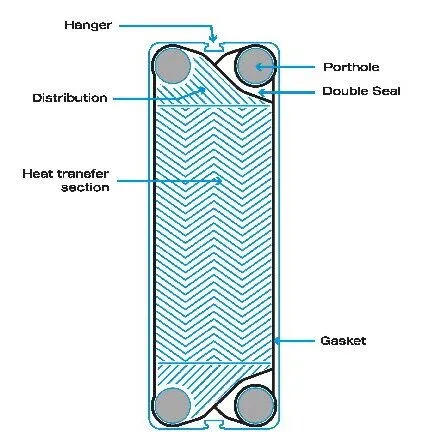Introducing Heat Transfer Plates of Plate Heat Exchangers
On this page
A plate heat exchanger is a high-efficiency, compact heat transfer device widely used in various industrial sectors, including chemical processing, pharmaceuticals, food processing, and HVAC (heating, ventilation, and air conditioning). The core component of this equipment is the heat transfer plates, whose design and materials directly determine the performance, efficiency, and lifespan of the plate heat exchanger. These plates are designed with unique corrugations that enhance fluid turbulence, significantly boosting heat transfer efficiency.

Structure and Working Principle of Heat Transfer Plates
Heat transfer plates are the primary components of a plate heat exchanger. Typically made from stainless steel or other corrosion-resistant alloys, each plate has four corner ports that allow fluids to flow through. These plates are clamped together within a frame consisting of a fixed plate and a movable pressure plate, secured by tightening bolts. The frame also includes connecting pipes that align with the corner ports of the plates to direct the two fluids involved in the heat exchange into their respective channels.
During operation, the two fluids flow in alternate channels between the heat transfer plates in a countercurrent flow pattern. Gaskets on the plates ensure that each fluid flows in its designated channel, preventing mixing and leakage. As fluids pass through the channels, the corrugated structure induces turbulence, increasing the contact area between the fluids and the plate surfaces, thereby enhancing heat transfer efficiency. This turbulence also helps prevent fouling on the plate surfaces, maintaining efficient operation over time.
Impact of Corrugated Design on Heat Transfer Efficiency
The corrugated design of the heat transfer plates is a key feature of plate heat exchangers, typically utilizing herringbone or diagonal patterns. These corrugations are arranged so that adjacent plates have opposite corrugation directions, causing the fluid flow paths to change constantly as they pass between the plates. This design creates intense turbulence, which enhances heat transfer by effectively disrupting thermal boundary layers between fluid layers and increasing the heat transfer rate.
The shape and depth of the corrugations significantly affect heat transfer performance. Generally, the corrugation depth ranges from 3 to 5 millimeters, and the thickness is between 0.6 and 1 millimeter. This design ensures sufficient turbulence to improve heat transfer efficiency while withstanding high-pressure conditions during operation. Optimizing the corrugated design can minimize flow resistance and enhance heat transfer, enabling the plate heat exchanger to operate efficiently.
Material Selection and Corrosion Resistance
Heat transfer plates are usually made from highly corrosion-resistant materials, such as 304 or 316 stainless steel or titanium alloys. These materials offer excellent resistance to various industrial media, extending the service life of the heat exchanger. In some special applications, such as handling highly corrosive chemicals, more resistant specialty alloys may be used.
Different materials for heat transfer plates can be selected based on the operating environment. For example, stainless steel is suitable for most common media, while titanium alloys are ideal for highly corrosive environments like seawater. These materials not only provide good corrosion resistance but also maintain strength and toughness at high temperatures, ensuring stable operation of the heat exchanger under various conditions.
Installation and Maintenance of Heat Transfer Plates
Proper installation of plate heat exchangers requires precise alignment and sealing to ensure uniform channels between heat transfer plates, preventing leakage and uneven flow. During installation, the seal between the heat transfer plates and gaskets is crucial and needs regular inspection and replacement to maintain effective sealing performance.
Maintenance of plate heat exchangers mainly involves regular cleaning of the heat transfer plates and gasket replacement. Due to the corrugated design of the plates and the narrow spacing between them, the equipment is prone to fouling and deposit buildup, especially when using poor-quality cooling water, such as river or seawater. The cleaning frequency depends on the operating environment and the nature of the fluids, typically requiring annual cleaning, but more frequent cleaning may be necessary in harsher conditions.
Cleaning methods usually involve disassembling the equipment, using a spray gun to wash the plates, and brushing off accumulated deposits. During cleaning, each plate and gasket must be inspected for damage; any damaged parts should be replaced promptly to prevent leaks and performance degradation during operation.
Applications and Advantages
Due to the efficient design and material selection of heat transfer plates, plate heat exchangers excel in various industrial applications, offering several key advantages:
High Heat Transfer Performance: The corrugated design of the heat transfer plates induces strong turbulence, significantly improving heat transfer efficiency, with typical heat transfer coefficients ranging from 3500 to 5500 W/(m²·K).
Compact Structure and Small Footprint: The unique arrangement of plates and compact design result in a small volume and lightweight heat exchanger, requiring minimal installation space.
Ease of Maintenance and Cleaning: The modular design of plate heat exchangers allows easy disassembly, cleaning, and replacement of components, saving maintenance time and costs.
High Flexibility: The number and material of the plates can be adjusted according to different operating conditions, meeting various heat exchange requirements.
Low Operating Costs: Due to high heat transfer efficiency, plate heat exchangers can reduce the required heat transfer area and cooling water volume, lowering operating costs.
As the core component of a plate heat exchanger, the design and material selection of heat transfer plates directly impact the equipment’s heat transfer efficiency, reliability, and service life. By optimizing the corrugated shape and material selection of heat transfer plates, the performance of the heat exchanger can be significantly improved, reducing operating costs and adapting to the demands of various industrial environments. Regular maintenance and cleaning help maintain the heat transfer efficiency of the plates, ensuring plate heat exchangers play a crucial role in various industrial applications. Their high efficiency, flexibility, and economic characteristics make plate heat exchangers indispensable heat transfer devices in modern industries.

